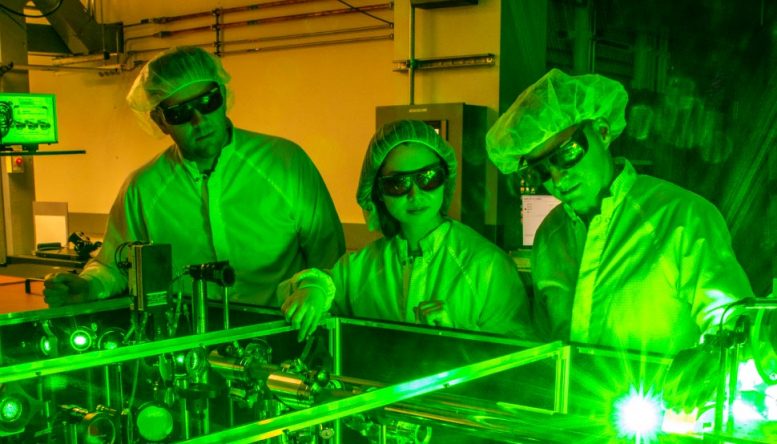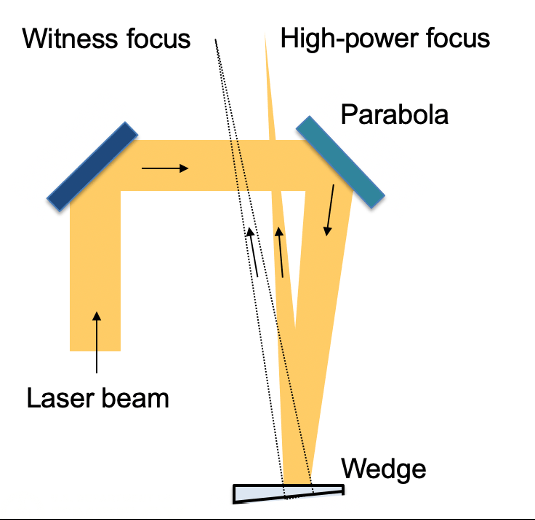
Berkeley Lab doctoral student Fumika Isono (center), BELLA Center Deputy Director Jeroen van Tilborg (right), and research scientist Sam Barber set up a novel laser stabilization experiment at one of the BELLA Center’s 100-TW-class lasers. Credit: Marilyn Sargent/Berkeley Lab
Berkeley Lab Optical Innovation Could Calm the Jitters of High-Power Lasers
The Berkeley Lab Laser Accelerator (BELLA) Center at the Department of Energy’s Lawrence Berkeley National Laboratory (Berkeley Lab) has developed and tested an innovative optical system to precisely measure and control the position and pointing angle of high-power laser beams with unprecedented
Measurement without disturbance
People think of a laser as being so precise that it passes into the language as metaphor, but users with demanding applications know that laser beams move around at a tiny scale in response to the vibrations and variability of even the most controlled lab environment.
“Missing the target by as little as a few microns can make the difference between amazing science and an unwanted addition to background noise,” said Isono.
Pointing angle offsets of less than a thousandth of a degree can result in unwanted complexities as well. That’s where diagnostic sensors and feedback systems come into play.
Measuring these parameters both accurately and without intercepting the beam is the trick. Traditional methods either greatly sap the power of the beam by intercepting its pulses (which at any rate is difficult for intense, high-powered beams) or suffer inaccuracies because they are not measuring the beam exactly as delivered. The BELLA Center’s innovative approach involves splitting off and monitoring a low-powered exact copy of the main beam, reflected from the rear surface of a specially designed final optic in the beam line.
The heart of this new approach is a laser architecture with three key attributes. First, it simultaneously provides five high-power pulses and a thousand low-power pulses per second, all following the same path. Second, the beamline design is optimized to keep the high-power and low-power pulses matched in size and divergence. Finally, it replaces one of the reflective beam line mirrors with an innovative wedge-shaped reflector that has specialty coatings on both the front and the rear surfaces.
Almost all of the main beam is reflected off the front surface of the optic without otherwise being noticeably affected. A tiny bit of the beam, representing perhaps 1% of the input power, propagates through the front surface and is reflected off the rear surface. This “witness beam” goes through any subsequent optics almost in parallel to the main beam, with just enough diversion for easy placement of measurement instruments. The end result is a witness beam with pointing angle and transverse position highly correlated to those of the main beam.
The result, said Isono, is “a measurement that won’t interfere with the main laser beam, yet very accurately tells us about it.”
Benefits for the BELLA Center and beyond
A near-future goal is using this diagnostic as part of a feedback system for active stabilization of the laser’s transverse position and pointing angle. Preliminary studies with the 100-terawatt laser at BELLA Center have been promising. The manuscript lays out the prospect of removing the jitters on the high-power 5 Hz laser by actively stabilizing the low-power 1 kHz laser pulse train. Laser beam vibration and motion was observed to occur on a scale of a few tens of hertz, which is well within the range of a practical feedback system. A fivefold improvement in position and angle of high-power laser pulse delivery is expected.

At the heart of the Berkeley Lab innovation is a wedge-shaped optic with a 99% reflective front surface for the main beam, and a wedged rear surface to reflect a low-powered witness beam. Both reflected beams are brought to a focus at nearly the same distance along near-identical paths, so the witness beam undergoes the same motions as the main beam. Credit: Berkeley Lab
The development of laser-